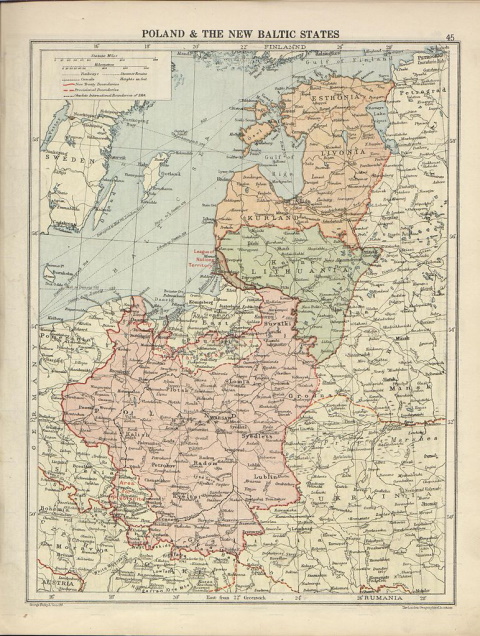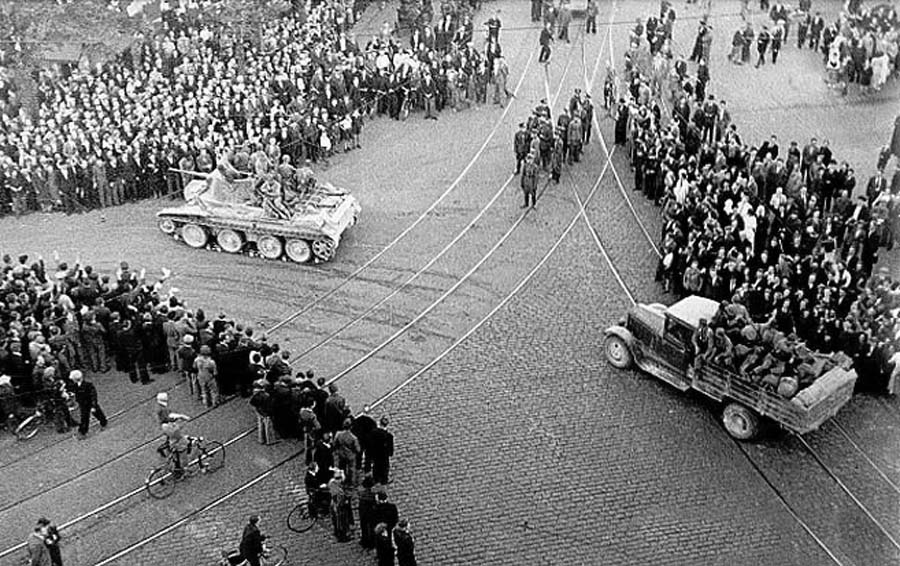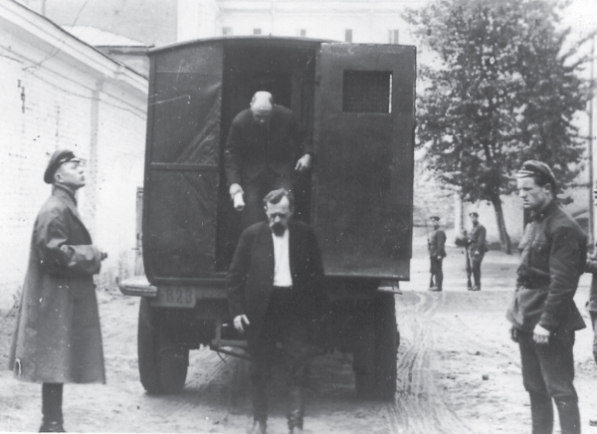

Table of Contents
It is often the destiny of small nations to be swallowed by the big ones. Human history has witnessed more than a few of them disappear as if they never existed. However, after the First World War, many of them, long forgotten, resurrected. The all-proclaimed right of self-determination gave birth to several new countries, old nations. Among them were three Baltic states of Estonia, Latvia and Lithuania. It was, however, their ill fortune that the peace established in Versailles was not destined to last long. Once a new storm loomed over the Old Continent, the independence of the Baltic countries was once again endangered. And so, after three decades of independence, former masters, now under the red banner of communism, abducted the freedoms of Estonia, Latvia and Lithuania. The Soviet occupation of the Baltic States that started in 1940 lasted for half a century.
A brief taste of freedom
In 1918, Baltic nations exploited the turmoil caused by the German defeat in the First World War and the October revolution the previous year, to seek independence. It took over two years of struggling between two fires in the Russian Civil War until Baltic states finally became free in 1920.
What followed were years of peace and progress for Baltic nations, who even turned to their advantage the fact that they were stuck between Germans and Soviets. Not only that neither of these two nations posed a threat anymore, but turned out to be suitable trading partners. With the Soviets, they even signed non-aggression pacts, thus eliminating the threat of military action from their closest neighbours.
The rise of authoritarian regimes in Europe announced a shift in relations that would ultimately lead to the occupation of the Baltic States. Joseph Stalin, the leader of the Soviet Union, tolerated the independence of Baltic states as long as they weren’t acting against his interests. However, the rise of Hitler in Germany was a warning sign. The German economic and political presence in the Baltic suddenly became an issue. For the first time, heads of Baltic states were warned that the Red Army was ready to intervene in case they sided with the Nazis.

Poland and the Baltic States, from London Geographical Institute - The Peoples Atlas - 1920.
Obviously, the Baltic states found themselves between two fires. Facing the same threat from the Soviets and the Germans as well, they tried to consolidate their forces by signing bilateral military agreements that in 1934 ultimately resulted in an alliance known as Baltic Entente. Even combined, the armed forces of the Baltic states could hardly withstand an attack from the Soviets. A funny story that circulated at the time best described the potential of the alliance. The Latvian commander-in-chief urged his Estonian colleague to send him heavy artillery. Estonian commander-in-chief responded with a question: “Both Cannons?”
The rapprochement of Germany and the Soviet Union in the late 1930s changed the situation completely. The three Baltic nations were no longer masters of their destiny. They became the prey of two powers and their arrangements.
Under the shadow of the red banner
On August 23, 1939, Germany and the Soviet Union signed the Molotov-Ribbentrop Pact. It was more than just a non-aggression pact, as it was proclaimed. It contained a secret protocol that arranged the division of Eastern Europe between the two powers. Victims of the agreement were: Poland that was to be divided between Germany and Soviet Union, Lithuania falling in the German sphere of influence and Finland, Bessarabia, Estonia and Latvia falling in the Soviet sphere of influence.
Even though they had a pact signed with Germans, Soviets were reluctant to let their guard down. They knew that, in order to prepare the defense of their country properly, they needed to control the Gulf of Finland and the Baltic region. For that reason, they pressured governments of the Baltic states and Finland into signing “mutual assistance agreements” that would allow Soviets to establish military bases in these countries.

Stalin and Ribbentrop after signing the non-aggression pact. German Federal Archives.
The course of events by that time showed that there was not much space for maneuver. By the end of September 1939, German and Soviet troops had already overrun Poland. Baltic states, with armed forces incomparably weaker than Polish, had no other choice but to comply with Soviet demands. Only Finland resisted and defended its independence in the Winter War.
According to the letter of the agreement, the Soviets could establish bases in the Baltic states with a limited number of soldiers. The truth was that the governments of Baltic states had no control over the operations and maneuvers of the Red Army troops on their territory. They knew nothing of the actual number of Soviets that entered their country. With military bases established, the Soviets set the stage for the total occupation of the Baltic states that would happen six months later.
The will of the People
It was clear as day that the Soviets were not satisfied with just a few bases. Baltic state leaders were very well aware of it, and there was absolutely nothing they could do about it. Already in spring 1940, they were preparing for the worst-case scenario. Some of their gold reserves were moved to the United States and Great Britain and plenipotentiaries were authorized among ambassadors abroad in case the country lost its independence.
The Soviets were active as well. Baltic communists rose from secrecy and started an aggressive campaign against the establishments in their countries. It was just a matter of the right moment for the Soviets to complete their goals and it came quickly, in May 1940. While the major belligerents were busy on the west of the continent, Soviets used the opportunity to complete the occupation of Baltic states. The first on the list was Lithuania. Even though, according to the Molotov-Ribbentrop Pact, it fell in the German sphere of influence, Lithuania was ceded to the Soviets. On May 25, 1940, Soviets accused the Lithuanian Army of kidnapping two of their soldiers. Further, Lithuania, along with other members of the Baltic Entente, was accused of anti-Soviet campaigning. All the efforts of the Lithuanian prime minister to resolve the dispute and assure Moscow of their loyalty to the mutual assistance agreement were futile. At midnight on June 14, 1940, Lithuanians were issued an ultimatum. The Soviets asked for two officials charged with anti-Soviet actions to be arrested, a new government “capable of fulfilling the arrangements of the pact” to be formed and for the entry of a new contingent of Red Army soldiers in order to ensure the proper enforcement of the pact. Similar ultimatums were handed to Latvia and Estonia the following day.
All alone against the Soviets, Baltic states succumbed to Soviet ultimatums. In just two days, on June 17 and 18, 1940, troops of the Red Army mastered the entire territory of Baltic region.

A Soviet BT Tank with a truck and troops in the center of Riga, 1940.
The arrival of Soviet troops was followed by a staged protest by Baltic communists who asked for a new government, one closer to the will of the people. Immediately, new, transitional governments were formed, with cabinets composed to suit Soviet wishes. Presidents of Estonia and Latvia were forced to resign and were deported to Soviet Union, after which they were never seen again. The Soviets threatened Baltic states as if they were still independent. Their incorporation in the Soviet Union was not to be done by force. People of the Baltic states had to show a wish for such a thing. Soviets were there just to make sure that the “will of people” was respected. In July 1940, general elections were held in Latvia, Estonia and Lithuania. At first, citizens were presented with two lists, but over time their choice was reduced to just one - the Communists. It was a true Soviet-style type of election.
Newly formed parliaments assembled on July 21, 1940, in all three states. The first thing they did was the formal application for membership in the USSR. The Supreme Soviet of the USSR joyfully accepted the applications of all three states. Lithuania, Latvia and Estonia became members of the Soviet Union on August 3, 5 and 6, respectively.
Black Raven
Along with the union came the iron grip of Stalin’s ruthless reign. In the days that followed the annexation, Soviets arrested thousands of former government members, army officers, public officials, industrialists and clergy of all denominations. After the threat from potential rebellion was eliminated with this first wave of arrest, Soviets continued to impose their reign of fear by arresting all citizens suspicious of anti-Soviet sentiment.
A grim story of those days was the one of the “Black Raven” (sometimes referred as “Black Maria”), a truck specially equipped with tiny prison cells driven by NKVD agents paying night visits to suspects. After combing the house, NKVD agents would take away their victim for questioning, a journey of no return. Sometimes the suspect would commit suicide, afraid of what was awaiting him. In such cases, the entire family would be taken away.
Prisons were filled with suspects. Those considered a significant threat would be taken to NKVD quarters for special treatment. In a suburb of Riga, there was a notorious “White House”, a headquarters of NKVD in Latvia with torturing chambers and tight prisoner cells.
The oppression was present in all spheres of society, from social life to economy. Before the war, Baltic states had solid economies and highly developed social life. With the arrival of the Soviets, it was all gone. They put big companies and industries under state control and their production subdued to five-year plans. Consumer goods shop owners kept running their businesses, but only as managers. With the obligation to satisfy the needs of the government agencies first, their stores were quickly left empty of goods. The purchasing power decreased significantly as all prices increased 100%. Only the price of vodka remained low. Farmers were the only ones who showed resistance to imposed collective farming, thus causing slow agricultural production.

Unknown, ‘Prisoners Exiting a Black Raven.’ Gulag: Many Days, Many Lives, Item #186
The communist authorities also put public activity under strict control. They abolished all ideologically unsuitable organizations and groups. These included religious groups, newspaper redactions, professional societies… They even put an end to the Boy Scouts. The oppression against religious institutions probably fell hardest on citizens of Baltic states, who were in the majority very religious. Many churches were converted for other purposes. When Christmas arrived in December 1940, factory workers threatened with a strike if they were not allowed non-working days to celebrate the holiday. Authorities gave in to their demands, but responded with massive arrests after the New Year. By the time of Easter 1941, no one dared to celebrate it publicly.
Even before the annexation, almost the entire administrative apparatus of all three Baltic states was replaced with politically fit personnel. The police force was replaced with workers’ militia. Armed forces have been swallowed by the Red Army, discharging most officers of the former army. The intensity of the oppression showed no decline as time passed. On the night of June 14, 1941, NKVD carried out a massive raid in all three states that resulted in over 100,000 arrested in each country. Entire families have been taken away and deported to unknown locations. In only 13 months of Soviet occupation, the Baltic states have gone from developed and happy countries to societies torn apart by communist oppression.
Liberation and Liberation
It was no wonder that citizens of the Baltic states welcomed the Germans as liberators when they arrived in late June and July 1941, as an invading army. Indeed, even though Baltic States were considered occupied territory, the German administration was considered far less harsh than the Soviet one. Baltic Nations have not been treated the same way as Baltic Jews, who have been exposed to genocide. They lived in peace, not disturbing the occupiers. Whatmore, they were allowed to take part in local administration and to keep schools open. Many Baltic nationals fought for the Germans on the Eastern Front. There were even three SS grenadier divisions comprising Esthonian, Latvian and Lithuanian soldiers.

Soviet infantry in battle near Riga, October 1944. Ministry of Defence of the Russian Federation
The change of tides of war on the Eastern Front in 1943 announced the return of the Soviets. Truly, it didn’t last long after the siege of Leningrad was lifted in March 1944 until Red Army troops launched the Baltic Offensive in autumn 1944 with the aim to reoccupy Baltic states. By the end of the year, the Soviets regained control over the Baltic states. Some areas, however, like the Courland pocket, held out until May 10, 1945.
For the Soviets, this was the liberation of three of their Soviet republics. For Baltic nations, this was the continuation of the occupation that started in 1940. This time, it lasted for much more than just 13 months. Baltic states regained their independence only in 1991, after 50 years of occupation. The last Russian soldiers to leave the Baltic did so in 1999. It was the crew of the Skrunda-1 radar station in Latvia.
Sources
Further reading
-
Misiūnas, Romuald, and Rein Taagepera. The Baltic States: Years of Dependence 1940-1980. University of California Press, 1993.
-
Tarulis, Albert N. Soviet Policy toward the Baltic States: 1918-1940. University of Notre Dame Press, 1959.
-
Saburova, Irina. “The Soviet Occupation of the Baltic States.” Russian Review 14, no. 1 (1955): 36. doi:10.2307/126075.
-
Felder, Björn M. “Stalinist National Bolshevism, Enemy Nations and Terror: Soviet Occupation of the Baltic States 1940–41.” The Baltic States under Stalinist Rule, 2016, 13-26. doi:10.7788/9783412506049-003.
-
Anušauskas, Arvydas. Lessons of History: The Silent Occupation of 1940. Lietuvos Respublikos Seimo Kanceliarija, 2014.
